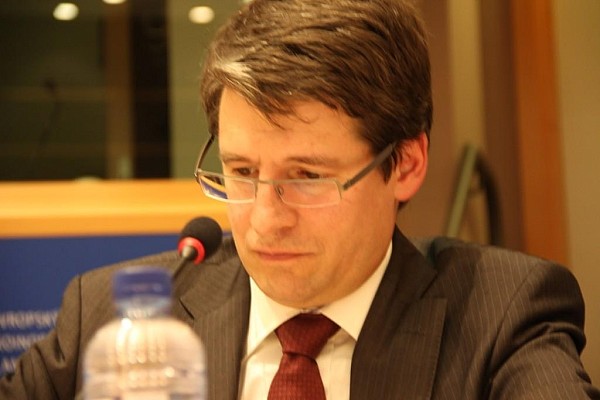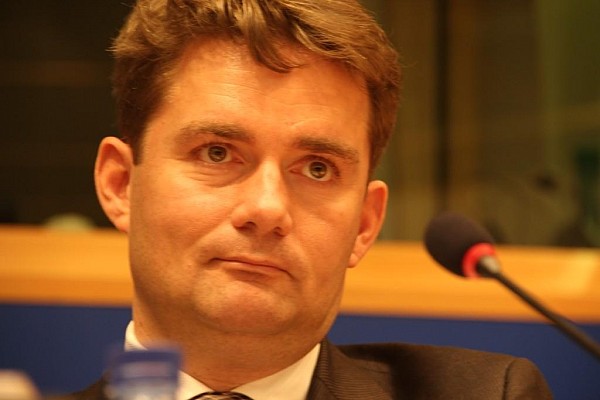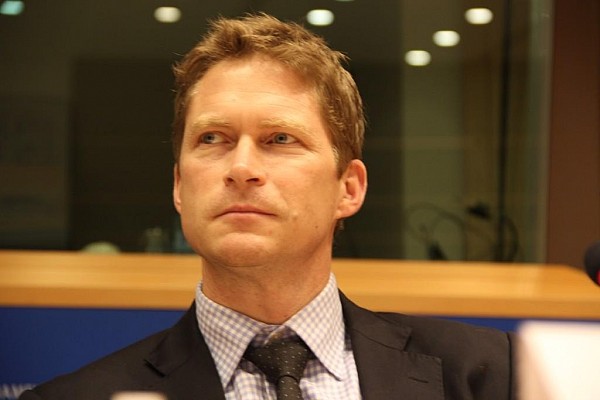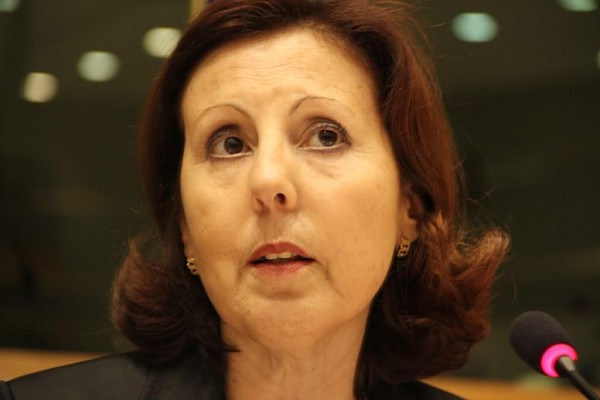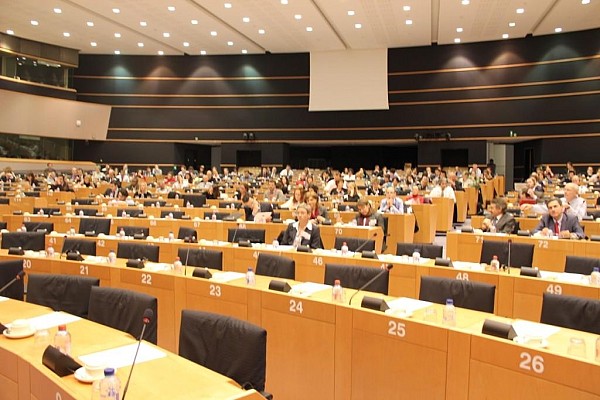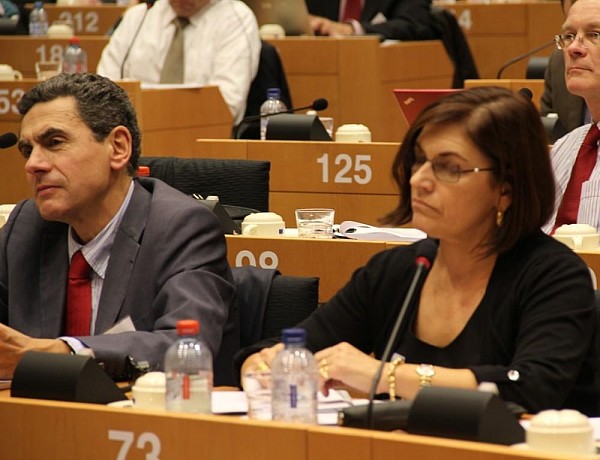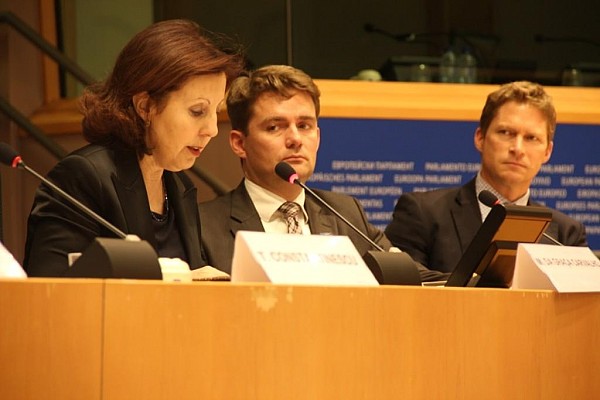Work in Parliament The Role of the EU Budget in Achieving the 2020 Energy & Climate Targets
The European Renewable Energy Council (EREC) held a conference in the European Parliament on role of the EU budget in achieving the 2020 energy & climate targets.
Maria da Graça Carvalho was speaker in the panel I, on The Future for Renewable Energy Research Funding (see intervention).
Setting the scene for the discussion, an EREC representative stated that the MFF had just been set and further communications and proposals will look into the details of its application. The European Commission (EC) had published the infrastructure package communication earlier that day, which is most relevant to this discussion. Furthermore, the Commission's Horizon 2020 call will be launched on the 30th November.
Key announcements include:
- Danish presidency may support a call for the doubling of research and innovation funding.
- Project bonds may become available as early as 2012.
- SET-Plan to be extended to offshore activities, heating and cooling, and energy storage.
- The Commission may try to produce a communication next year on the direction of renewables until 2030.
- The Commission may launch an initiative on this in the form of a call for proposals on heating and cooling.
Panel I - The Future for Renewable Energy Research Funding
Jorge Nunez-Ferrer, Centre for European Policy Studies (CEPS), moderated the first panel and stated that Maria da Graca Carvalho (EPP, PT) had asked for the doubling of the current FP7 funding for the new Horizon 2020 funding programme. The Commission has proposed €80 billion, which is €20 billion more than the current available amount. He therefore asked her whether this sum was sufficient to address the EU's research and development needs. He went on to ask her how she saw renewable energy fitting into this budget.
Maria da Graca Carvalho (EPP, PT), member of the ITRE committee, answered by saying that she had tabled an amendment in ITRE, which was supported by the EPP and then by all other political groups, asking for the next programme for 2020 to have €100 billion allocated to it. She has also called for an increase in the use of structural funds for research and innovation. 30% of structural funds are being used for R&D (about €90 billion). She hopes to have another €100 billion made available from structural funds, totaling €200 billion with the Horizon 2020 sum, devoted to research and innovation. The Member States have to agree with these priorities.
During her intervention Maria da Graça Carvalho said that the report was now finished on how to increase the synergies between the framework programme and the structural funds, and on how to make it easier for member states to apply the funds from both. The report includes a package of recommendations on this. Most of the time, Member States do not devote a lot to research and innovation because of the complexity of the structural funds. If not used in time, these funds are then lost. Regions and Member States could potentially finance European Research Council grants above a certain level where the Commission will not provide funding. Commissioner Barroso initially announced the project bonds for 2014, but following the plan for stability and growth announced last week, they will probably become available as early as 2012. She hoped that these bonds were not just for infrastructure, but for innovation and demonstration projects too. The EIB should also be increasingly used for innovation projects. We should incentivise our financial system to finance the real economy and innovative projects that could have a return in the medium term. This is a multi-fund approach for the future to meet the funding needs which are large and cannot be provided by the public sector alone.
The priorities for Horizon 2020 have not yet been discussed, but the overall guidelines have. She wished to align the next generation of programmes with EU priorities. In the past, there have often been priorities that were not reflected in budgets. Environment and climate change is not a priority in the present programmes, but does have funds allocated to it. Energy, climate change, health, active ageing, food security and quality, are now all political priorities and we have seen an increase in the budgets for these areas (for clean air and renewables in particular). Also important is how easy access to the funding options is, as well as ease of execution. We currently have less than 30% execution in terms of structural funds, because of co-financing requirements and the complexity of the process, principally for SMEs and universities. The final decision on the amounts of funding for certain things will be negotiated between the institutions. She hoped that the Council will support the Parliament and Commission's wish to raise the funds for research and innovation. Countries like the Netherlands, Ukraine, Sweden, will support this.
Jorge Nunez-Ferrer asked what would happen with the SET-Plan and where will the financing come from. What will happen in the future if it needs to expand into other industrial initiatives such as heating and cooling, for example?
Tudor Constantinescu, Principal Adviser to the Director General for Energy, European Commission replied that the SET-Plan has 7 industrial initiatives, but the issues of marine activities, heating and cooling, and energy storage will be added in the future. The EU budget will never have enough money to meet the needs in these areas. Research is one side of the coin, and then there is deployment which needs policy measures. Sustainability, competitivity, and decarbonisation are needed to move ahead, in terms of worldwide encouragement too. 45% of the FP7 energy budget was for renewables, but the structural funds were not used enough, which he would like to see changed. Industry has to play a proactive role. Behaviours also need to be changed, and technical assistance and capacity building at the institutional level also need to be worked on. Real deployment policies are key.
Jorge Nunez-Ferrer asked how the EU and member states can compliment each other, and what could be done to improve this. Last year, developing countries beat developed countries in terms of financing renewable energy projects. What do we need in Europe to promote Europe as a global player in the renewable energy sector, and how should Member States act?
Nicolai Zarganis, Director, RD&D, Danish Energy Agency, replied that he was not able to answer how we can compete on the global scale, but knew that the answer was beyond funding research and innovation. We do have some competencies and experiences to build on in Europe, but we have very high environmental and climate ambitions and so need cost effective solutions. On EU and Member State efforts, we can compliment efforts in several ways. We need to drive down the cost of commercialising new technologies. We must look at the entire chain. We need funding, but we also need to put new tools in place to assist market development in these technologies. We need regulation for this. Wind is certainly a sector which has benefitted from that kind of regulation in recent years. We need a comprehensive long-term framework for investments in these technologies. Member States should build on the competences and experiences in their own member states. The EU should focus on the common challenges. More funding is of course necessary, and the Danish will take over the Presidency in January, is in favour of doubling funding for research and development, whether through Horizon 2020 or structural, he was not sure. More transparency would also be desirable. There are national funding programmes which are open to other countries too, which is not often known.
Jorge Nunez-Ferrer asked if industry needed more public support for R&D, and why. If the next speaker's company had participated in EU projects, what successes could be relayed from these, he asked.
Jens Martin Aslbirk, Manager Market Access, Vestas Wind Systems A/S, said that his company was clearly hit by the financial crisis as it somewhat reliant on public financing. It has reduced its manufacturing presence in Europe in the last year. Their approach was to invest their way out of the crisis through R&D. It is not a consolidated industry as it sees rapid technology deployment. They have 2000 people in the research and development department of the company, worldwide. They finance all of that themselves, and are ready to commit part of this to public projects. Every year there are more calls for wind projects, than there is funding to support them. Targets for wind are very ambitious, and much funding is needed for this. He appreciated the Horizon proposal, which is clear progress on the FP7. He hoped that the EU would present a more user friendly package (structural, EBRD, EIB, FP7 etc). The company had engaged in many different projects. When it comes to developing next generation turbines they would do this for themselves only, but can share findings in terms of installation procedures for offshore facilities which are on the rise. They are trying to develop a floating platform at the moment.
Q&A
A representative from WWF said that the FP7 currently has 70 people working on nuclear energy research and only 16 for renewables and energy savings. There is a big imbalance in terms of money allocated to both sides, and this does not match the aims of the 2020 targets. He therefore made a demand for this to be rebalanced. Everybody is obsessed with the cost effectiveness of projects, and the ITER project is given a significant amount of EU research money, and this does not seem the best example of cost effectiveness, and so he questioned whether this should remain in the EU budget.
Jorge Nunez-Ferrer raised the issue of ensuring additionality. The amount of public money for R&D is not that much lower than in the US, the difference is more in the private sector contribution. Is it right to keep adding public money, he asked.
Maria da Graca Carvalho (EPP, PT) replied that Euratom has a different treatment and treaty altogether, with a separate budget from the framework programme. The ITER project recently requested extra funding, and negotiations are currently taking place on where to get this funding from. The Parliament's position is that the extra funding should not come from the FP7 fund (2012-2013) or the future one, but from unused margins from other categories. She recognised the value of the project though, as we need to invest in future technologies.
Tudor Constantinescu (EC) agreed with Carvalho's answer, and clarified the difference between funding for fission under the FP7, and ITER, which is a separate project. Fission energy will produce much less waste and will require much fewer resources than current nuclear plants. If we do not act, we will see these plants in China first. 45% of the FP& energy fund is for renewables, and the economic recovery plan allocated €1 billion for CCS and €570 million for offshore wind, he recounted.
Jens Martin Aslbirk (Vestas Wind Systems) could understand the point from WWF. He was pleased with the way the budget was moving, with the specific budget line for wind and solar, however small. In terms of incentivising the private sector, we are already doing this, he said.
Jorge Nunez-Ferrer asked whether there was something stopping R&D in other countries.
Nicolai Zarganis (Danish Energy Agency) said that industry needs a long-term framework, and it is partly the role of Member States, but mainly the role of the EU to provide the framework. We can only hope for more of this kind of regulation, like the energy efficiency directive etc. The EU could also encourage Member States to embark on international cooperation projects.
A participant from the German Hard-Coal Industry said that on the road to a decarbonised economy, we need to be able to store large amounts of energy if we are to have more renewables. He asked what the Commission was doing towards this.
Another participant saw the need for more support for smaller scale projects in renewable heating and cooling. There is a need for consistency in research programmes and calls, as well as a streamlined procedure.
Tudor Constantinescu (EC) replied that, the Commission wishes to develop a competitive and sustainable EU energy policy. On the roadmap, renewables will be one of the main areas therein and will offer options. We need to continue to develop offshore wind, and so need a flexible grid to accommodate renewables and accommodate the needs of the customers with a demand management capability. The Commission will maybe try to produce a communication next year on renewables with direction for 2030. The development of a grid with capacity for storage and hydrogen may be an option for the future, with wind too. Heating and cooling continues to be important, and may have an initiative on this in the form of a call for proposal. Cogeneration is an important element of the energy efficiency proposal. How to harmonise solutions at the national level and some elements at EU level is a big challenge.
Maria da Graca Carvalho (EPP, PT) supported the Commission's position. Energy storage will be a priority, and much needs to be done in terms of research. Legislation on heating and cooling is very important. Combined heat and power (CHP) /cogeneration are included in the parliament draft report on energy efficiency. She will table amendments stressing the importance of micro CHP.
Jorge Nunez-Ferrer predicted fights in the council on this issue. There is friction around net balances, for example.
Panel II - Financial Instruments for Energy Infrastructures
Frauke Thies, Senior Energy Policy Adviser, Greenpeace, moderated the panel, and stated that infrastructure is not just about power lines but technical updates of existing ones, and also looks at heating networks and energy storage. She asked Karins, Latvia needs grid infrastructure to connect it to the rest of Europe. How can we make sure they are built, and who will pay for them.
Krišjānis Kariņš (EPP, LV) said that it has only been 20 years since the Baltic States were fully connected to the Soviet Union energy infrastructure, and they are still relatively isolated now, which brings potentially very negative consequences as a result of the large dependency on Russian energy, or Gazprom's energy. Latvia is 63% dependent on Russian energy, Lithuania over 80% and Estonia 30%. There is one electricity interconnection between Tallin and Helsinki, and a line is being planned between Lithuania and Sweden and Poland, without loosing the connection to Russia, but the same does not exist for gas. On the electricity side, unbundling has occurred, mainly because there were state owned monopolies. Again, not for the gas sector. Latvia and Estonia have a derogation on the third energy package until they are no longer isolated, but who in their right economic mind would want to invest in this relatively small market where the competition is Gazprom who could lower its price to zero until other companies fold, and then raise them again. An LNG terminal is a potential solution, but there is the question of where the money comes from. The infrastructure communication today proposes some kind of solution, and will invest billions in this sector, especially where it is not commercially viable to do so. The Baltic states have an underground gas storage facility which supplies Russia in the winter, which is the only thing stopping Russia stopping the gas supply to these states when they 'behave badly'. A common grid will help to reach all the Baltic's goals. The Commission's proposal represents a real solution.
A representative from the Jeffrey Seisler from Clean Fuels Consulting questioned whether investing in interconnection in the Baltic will take away from investments in the renewable sectors.
Krišjānis Kariņš (EPP, LV) replied that, in his understanding, the facility comes from a separate fund and should not impinge on the development of alternative energies. There is much biomass in Latvia, and companies are interested in investing in it, but no network means no investment.
A representative of SCOM asked about the future being of the Intelligent Energy Europe programme.
Krišjānis Kariņš (EPP, LV) said that he was one of co-signers asking for this funding not to be lost, but this is a political question.
Frauke Thies on the financing element of the infrastructure package, €140 billion is said to be necessary for the electricity transmission structure until 2020, and about €52 billion may not be commercially viable. €9 billion is allocated for energy infrastructure, and so she asked how the remaining gap would be filled. She also asked about the division of the €9 billion since there has been no advance earmarking.
Christophe Schramm, Policy officer, Unit Internal Market "Networks and Regional Initiatives", European Commission DG ENER, replied the following on the new infrastructure package:
- New infrastructure fund has separate regulations dealing with the three sectors. Total of €50 billion with 9.1 to energy.
- It proposes an energy regulation for the trans-European infrastructure, to replace the current TEN-E framework.
- Fully integrating the Baltic energy markets is one of the key priorities.
- Developing offshore grids, a firm gas corridor, N-S electricity and gas networks, smart grids are all covered in the communication. Beyond 2020, there is the possibility of developing electricity highways and CCS networks.
- The aim is to implement all by 2020. The procedure will involve identifying projects of common interest, of a regional or thematic nature, and a toolbox to facilitate the commissioning of building the infrastructure. There will be measures for permit granting and a consultation on the regulation on how to allocate costs of cross-border infrastructure, and funding for projects that really need it.
To reply to the question, he said that €200 billion will be needed up to 2020, and roughly two thirds (about €140 billion) will need to go to electricity in order to reach the 202020 targets. We are not yet in the market phase in the classical sense because energy is a regulated businesses, i.e. the price is not fixed by market, but by regulators. This has worked well in terms of building infrastructure in the last decades, but we are about to see a major change now because of the urgency of time pressure and the wide scope of the needed changes. Existing regulation may not always allow for the funding of projects we think are necessary. Simple grants, innovative financial instruments like equity instruments (for example the possibility of EU budget to be used for an investment fund which feeds equity infrastructure projects) or risk sharing instruments, like project bonds and other types of guarantees or concessional loans which could be issued by the EIB, for example. €9 billion has been proposed for the period of 2014-2020, for grants, through TEN-E, the programme for recovery, but also as part of the budget to financial instruments. The leverage effect depends on each instrument. Leverage can be different if it is accompanied with a guarantee. Projects with specific technical challenges (offshore, storage) or that deal with security of supply are deemed to be of common interest and would have to go through the application process.
Frauke Thies asked whether he could specify how much in general will go towards electricity. 12 projects have been identified in the annex, 6 linked to fossil fuels, and 6 to electricity. Is this an indication of the division of the funds, she asked.
Christophe Schramm (EC) said that this was not the case. Oil will not be eligible for any kind of funding. Access to grants for works will be conditional, and will depend on the nature of projects. Two thirds of investment is needed for, and so maybe more will be invested in electricity. There will need to be significant investment in gas projects and some gas pipelines too, so it is hard to say at present. The leverage factor for project bonds could be up to 20. This is the most optimistic figure, so it might be much lower, and does not necessarily apply to other instruments or grants.
Frauke Thies, said that the infrastructure package will pass through Council during the Cypriot presidency. What does it matter to island country like Cyprus to get infrastructure sorted in Europe.
George Papageorgiou, Industrial Extensions Officer, Dep. of Energy, Ministry of Commerce, Industry and Tourism of Cyprus, said that the presidency will lead discussions during tough economic times. If the energy and climate objectives are to be achieved, there should be a coordinated EU approach to identify and fund selected projects. In the current situation, there is a general lack of transparency on investments in infrastructure by TSOs, which needs to be tackled. The latest Commission analysis estimated that energy and climate objectives will need €1 trillion in investment. We need €200 billion for trans-European networks alone, of which €140 billion will be needed for high voltage electricity transmission systems. €70 billion will be needed for gas infrastructure. This leaves a €100 billion gap, and obstacles relating to permit granting and existing financing frameworks. Permit granting procedures are lengthy, and we need more efficient systems. The estimated cost of lengthy procedures makes up to 10% of project costs, which contributes to non or late completion. The social and economic benefits of the proposal are significant, he said. 775,000 jobs could be created between 2011-2020 and €20 billion could be added to GDP. Cyprus, is an island isolated from any energy networks and is almost entirely dependent on imports. The milestone for 2012 has been exceeded. Current infrastructure cannot support renewable energy, and so connecting to networks with the rest of Europe is the solution.
Frauke Thies said that in the infrastructure package, the need to support projects of European interest has been identified. She asked who has to pay for this though. Some projects may involve two countries in infrastructure terms, but may benefit others. The Commission says regulators should help with cost allocation. How should this allocation be done, she asked. 6 corridors for electricity have been proposed. Is this choice right, she asked.
Gunner Lorenz, Head of the Networks unit, EURELECTRIC, believed that the general objective of the package is a very good stepping stone for the trans-European networks. The package is needed for better integration of the EU market, renewables and security of supply. Priority corridors are supported. He welcomed smart grids as a priority. He trusted that the ten year network development plan (TYNDP) is going in the right direction. The one stop shop for acceptance of new lines is also very good. Much analysis has been done, but he could see that not much has happened in the last few years because of the authorisation procedure. On the market and regulatory approach, it was clear that all support the creation of an energy market. For natural monopolies, there has to be a regulator stimulating the market. For cross-border markets, this means that one might want to build a line between country A and B, and country C will benefit. So the question of who pays needs to be looked at. National policy makers should identify what the benefits and costs are and share the cost fairly. The EU multi Member State approach is the right one, but one thing in cost benefit analysis is that ENTSO-E is to prepare the methodology, using DSO expertise too, and so EURELECTRIC is open to cooperation with ENTSO-E. There should be an open process and ENTSO-E should take on the experiences within EURELECTRIC.
Many figures are floating around and the IEA, for example, says that investment in distribution is three times higher than for transmission. A lot of action is needed, especially investment in smart distribution networks which will support renewable and low carbon technologies. He believed these investments will turn out to lower the overall cost of the system, but there is a lack of incentive to invest, which should be addressed by national regulators. National regulators have a narrow view, and it is necessary to look at the wider EU picture. ACER, in terms of cross-border investments, has to play a crucial role in harmonizing approaches as much as possible. The power of the Commission is limited when it comes to national regulatory approaches.
Frauke Thies strongly supported the smart cities initiative, and also thought that smart grids infra and district heating and cooling (DHC) are part of the answer. She asked the following speaker to inform the room about the smart grid imitative, and how much cities were benefitting from the infrastructure package. She then asked what the best financing solutions were, as well as what the role structural funds and the ELENA fund could have.
Brigitte Bach, Director of the Energy Department, Austrian Institute of Technology, replied that the smart cities initiative is the only industrial initiative focusing on the demand side in the SET-Plan. The initiative now has a call on DHC and retrofitting, and another call is expected next year. She was looking to Horizon 2020 to see if funding was available too. The initiative will also try to organise a member state initiative from December with all 27 and the Commission to discuss what there is on programming, high level projects and what level of money is necessary from the Commission. She hoped to have a recommendation on funding for research and piloting from Horizon 2020. 2050 is just one innovation cycle away from now. We need a full rethinking of how to supply cities' demand, and so we need a completely new way of urban planning and to link it to infrastructure planning. The energy system needs a holistic approach, management-wide too. We must set up a new framework for planning, but makes life for stakeholders and investments complex because it will not be up to one investor to know what is best for a city. We need a funding system for research, for tools and methods for integrated planning, piloting, and we need to have enough funding for an ambitious rollout deployment. Structural funds and ELENA could play an important role.
A representative from CEE Bankwatch Network recognised the problem of investment, lack of instruments and public financing to bring projects to commercial viability. EIB has a role to play, and when looking at the energy lending portfolio, he found that there had been increases in lending to fossil fuel projects such as pipelines, coal and gas power plants. He asked whether we could afford to continue such investments, and whether the Commission had a plan to bring the energy lending of the EIB in line with climate targets.
The WWF representative wished to clarify that for long-term energy infrastructure, the most relevant target is the 2050 climate target of 80-95% emissions reductions. He asked what methodology was used for energy and transport projects, facility and project bonds and carbon analysis of each projects. How is this climate assessment used to modulate investment for most low carbon projects, he asked. He thought that DG ENER underestimated the potential for renewable energy and savings, giving too much public support for gas infrastructure. On project bonds, how will the Commission make sure the projects will be consistent with the 2050 targets and will not support fossil fuel infrastructures too much. He asked whether the Commission would make sure energy saving projects are in the scope of project bonds, because they seem to be excluded at present. By grouping middle scale projects they could be considered as higher scale projects. Will such decisions be left the EIB, he asked.
Another participant addressed Bach on her comment that we need a new way of planning, and so need a holistic approach. How can we put this into action when we know that most cities need refurbishment policies and need upstream decisions and well defined small scale projects, they asked.
A representative of Smart Cities Denmark said that smart cities is about deployment of services too. What remedies are envisaged for deployment, they asked. Have DSOs will need to draw up standards on roaming etc, to be able to provide for renewables for electric vehicles etc.
Brigitte Bach replied that smart cities is complicated issue. There are small and large scale projects, green and brown field development etc. The stakeholder process is set up with the Mayor, DSOs, heads of public companies providing public services, the building sector. All then agree together how to achieve targets and make things operational top-down, whilst allowing for bottom-up input into planning. We need investment on all levels. Small scale projects could perhaps benefit from the structural funds, if they were easier to deal with. This is also about creating new business models, to be a supplement to funding.
Christophe Schramm (EC) on the question of EIB financing of fossil fuel project said that EIB loans are not necessarily more advantageous than other commercial funding, so the Commission proposes that for projects of common interest that use financial instruments to allocate EU budget, for specific instruments, terms of reference will be set on how money should be spent. He fully agreed that what is built today will still be around in 40 years time, but argued that anything identified as a priority for 2020 and beyond will be necessary, whatever the energy future is.
He had had a discussion on energy efficiency with the Parliament and we can reduce the need for additional infrastructure to a point. The carbon impact is addressed in annex 5 of the package, where you can find information on the impact of projects on Co2 prices and climate resilience. This is very much considered in the cost benefit analysis. On the idea of increasing funding for most climate friendly projects, criteria include innovation, solidarity and security of supply, but climate friendliness is not mentioned explicitly. He assumed that most electricity and some gas projects will have a positive effect on climate. On the extent to which there is too much support for gas and not renewables, some member states who developed their renewables significantly over the last few years, also developed a lot in gas. He could not pre-judge what would happen now. On project bonds, he said that gas and energy efficiency projects will be for transmission infrastructure only. Energy efficiency is not part of this, so there will be no project bonds for gas fired power plants, wind or solar plants.
